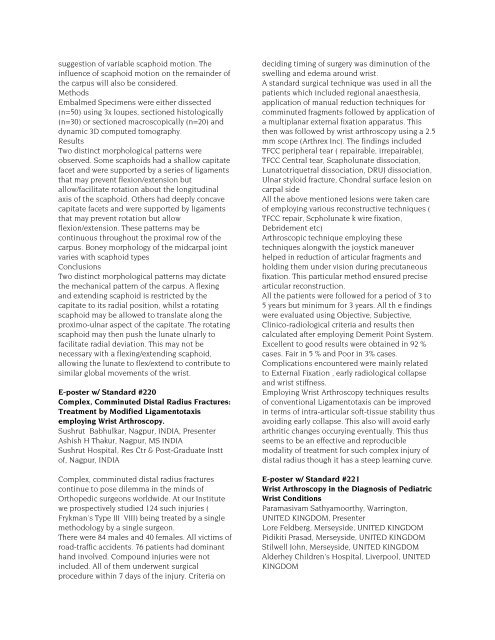POSTER ABSTRACTS - ISAKOS
POSTER ABSTRACTS - ISAKOS
POSTER ABSTRACTS - ISAKOS
Create successful ePaper yourself
Turn your PDF publications into a flip-book with our unique Google optimized e-Paper software.
suggestion of variable scaphoid motion. The<br />
influence of scaphoid motion on the remainder of<br />
the carpus will also be considered.<br />
Methods<br />
Embalmed Specimens were either dissected<br />
(n=50) using 3x loupes, sectioned histologically<br />
(n=30) or sectioned macroscopically (n=20) and<br />
dynamic 3D computed tomography.<br />
Results<br />
Two distinct morphological patterns were<br />
observed. Some scaphoids had a shallow capitate<br />
facet and were supported by a series of ligaments<br />
that may prevent flexion/extension but<br />
allow/facilitate rotation about the longitudinal<br />
axis of the scaphoid. Others had deeply concave<br />
capitate facets and were supported by ligaments<br />
that may prevent rotation but allow<br />
flexion/extension. These patterns may be<br />
continuous throughout the proximal row of the<br />
carpus. Boney morphology of the midcarpal joint<br />
varies with scaphoid types<br />
Conclusions<br />
Two distinct morphological patterns may dictate<br />
the mechanical pattern of the carpus. A flexing<br />
and extending scaphoid is restricted by the<br />
capitate to its radial position, whilst a rotating<br />
scaphoid may be allowed to translate along the<br />
proximo-ulnar aspect of the capitate. The rotating<br />
scaphoid may then push the lunate ulnarly to<br />
facilitate radial deviation. This may not be<br />
necessary with a flexing/extending scaphoid,<br />
allowing the lunate to flex/extend to contribute to<br />
similar global movements of the wrist.<br />
E-poster w/ Standard #220<br />
Complex, Comminuted Distal Radius Fractures:<br />
Treatment by Modified Ligamentotaxis<br />
employing Wrist Arthroscopy.<br />
Sushrut Babhulkar, Nagpur, INDIA, Presenter<br />
Ashish H Thakur, Nagpur, MS INDIA<br />
Sushrut Hospital, Res Ctr & Post-Graduate Instt<br />
of, Nagpur, INDIA<br />
Complex, comminuted distal radius fractures<br />
continue to pose dilemma in the minds of<br />
Orthopedic surgeons worldwide. At our Institute<br />
we prospectively studied 124 such injuries (<br />
Frykman’s Type III VIII) being treated by a single<br />
methodology by a single surgeon.<br />
There were 84 males and 40 females. All victims of<br />
road-traffic accidents. 76 patients had dominant<br />
hand involved. Compound injuries were not<br />
included. All of them underwent surgical<br />
procedure within 7 days of the injury. Criteria on<br />
deciding timing of surgery was diminution of the<br />
swelling and edema around wrist.<br />
A standard surgical technique was used in all the<br />
patients which included regional anaesthesia,<br />
application of manual reduction techniques for<br />
comminuted fragments followed by application of<br />
a multiplanar external fixation apparatus. This<br />
then was followed by wrist arthroscopy using a 2.5<br />
mm scope (Arthrex Inc). The findings included<br />
TFCC peripheral tear ( repairable, irrepairable),<br />
TFCC Central tear, Scapholunate dissociation,<br />
Lunatotriquetral dissociation, DRUJ dissociation,<br />
Ulnar styloid fracture, Chondral surface lesion on<br />
carpal side<br />
All the above mentioned lesions were taken care<br />
of employing various reconstructive techniques (<br />
TFCC repair, Scpholunate k wire fixation,<br />
Debridement etc)<br />
Arthroscopic technique employing these<br />
techniques alongwith the joystick maneuver<br />
helped in reduction of articular fragments and<br />
holding them under vision during precutaneous<br />
fixation. This particular method ensured precise<br />
articular reconstruction.<br />
All the patients were followed for a period of 3 to<br />
5 years but minimum for 3 years. All th e findings<br />
were evaluated using Objective, Subjective,<br />
Clinico-radiological criteria and results then<br />
calculated after employing Demerit Point System.<br />
Excellent to good results were obtained in 92 %<br />
cases. Fair in 5 % and Poor in 3% cases.<br />
Complications encountered were mainly related<br />
to External Fixation , early radiological collapse<br />
and wrist stiffness.<br />
Employing Wrist Arthroscopy techniques results<br />
of conventional Ligamentotaxis can be improved<br />
in terms of intra-articular soft-tissue stability thus<br />
avoiding early collapse. This also will avoid early<br />
arthritic changes occurying eventually. This thus<br />
seems to be an effective and reproducible<br />
modality of treatment for such complex injury of<br />
distal radius though it has a steep learning curve.<br />
E-poster w/ Standard #221<br />
Wrist Arthroscopy in the Diagnosis of Pediatric<br />
Wrist Conditions<br />
Paramasivam Sathyamoorthy, Warrington,<br />
UNITED KINGDOM, Presenter<br />
Lore Feldberg, Merseyside, UNITED KINGDOM<br />
Pidikiti Prasad, Merseyside, UNITED KINGDOM<br />
Stilwell John, Merseyside, UNITED KINGDOM<br />
Alderhey Children's Hospital, Liverpool, UNITED<br />
KINGDOM
















